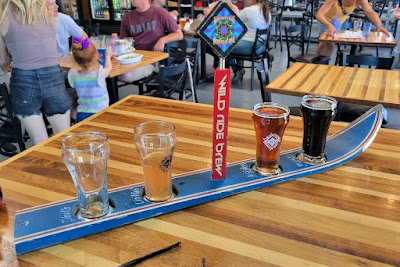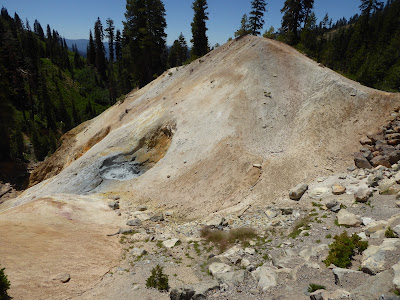We left Redding, California heading north on I-5 to scenic Highway 97 heading to Diamond Lake, Oregon. Highway 97 is called the Volcanic Legacy Scenic Byway All American Road. The scenery was breathtaking. Lots of volcanos/mountains and pine trees. We went right past Mount Shasta with gorgeous views.
We arrived at Diamond Lake RV Park, about 15 miles north of Crater Lake. There are not many campgrounds in the area, and it is very rustic. The campground had no TV signal, cell reception or wi-fi. It's amazing how accustomed we've become to our phone and internet. It's not a bad thing to disconnect. However, when in a vacation area, it would have been nice to be able to use our maps app and look up information. We managed!Diamond Lake is beautiful with Mt. Bailey on one side.
We spent one day driving along Highway 138 to view some waterfalls. The campground had given us a map with six falls. We visited four of them. The first was Clearwater Falls. It was close to the parking lot.The second one was Whitehorse Falls, also close to the parking lot.Third was Watson Falls. This one was about a one mile roundtrip, uphill all the way to the falls.The last one was Toketee Falls. This was also over a mile roundtrip with lots of stairs.The next day we headed to Crater Lake National Park, entering at the North entrance. Here's the first viewpoint we came to. The color of this lake is the deepest blue I've ever seen on a lake. According to a ranger, the reason is the depth reflecting back the deep blue color. The deepest part is 1,943 feet. If you put the Statue of Liberty on top of the Washington Monument on top of the Eiffel Tower, you would still have 20 feet of water before reaching the top. That's deep!! It is the deepest lake in the US, and the ninth deepest in the world. The lake is six miles long and five miles wide. It was formed about 7,700 years ago when Mount Mazama erupted and collapsed in on itself forming this caldera. Snow melt and rain filled in the crater. The water level does not fluctuate much.
Here's what it looks like on the rim of the lake at this viewpoint. You can't see it, but there is a fire watchtower up there.We headed to the visitor center where we purchased tickets for a two hour trolley tour, narrated by a ranger. Senior price was $34 each, and well worth it. There were six stops along the route, and we learned so much more than if we had just driven around and read the signs.I took some regular and panoramic pictures. Here are some of my favorites. You can click on any of the pictures to enlarge them.
 |
| Although there is some sun glare, this was the best spot to get all of the lake in the picture. |
The island above is called Wizard Island and is a cinder cone that formed from the eruption. In the picture below, you can see a small island on the left side. This is called Phantom Ship, and is some lava peaks sticking out of the water.
Here's a closer look.In some spots along the shore, the water looks more green because it is shallower.
Here we are at the Visitor Center with Wizard Island in the background.I like the shadows in the pictures below. I noticed that the color of the lake looked different in the morning versus the afternoon depending on the position of the sun. We had a very clear day with almost no clouds.
Here are some more pictures. I had a hard time deciding which to include, so you get to see lots of them!The park encompasses over 183,000 acres. The lake is just a part of that. Here are some views looking away from the lake. In the distance is Diamond Lake and Mt. Bailey where we are staying.
In the photo below, you can see Mt. Shasta over 150 miles away. It's faint and in the center of the picture. Click to enlarge.
This is Vidae Falls on the East Rim drive. The water comes from Sun Creek in the park. No streams or springs are in Crater Lake. All the water in the lake comes from snow melt and rain.
As we were headed back home on the North entrance road, I snapped this picture. As you can see, the trees on the left are all burned, and the ones on the right are nice and green. The ranger told us this was done on purpose when a fire was threatening to reach the park. They started this back fire to keep the big fire away, and it worked. The fire did not reach the park, and did not cross the road.
We have seen so many burned areas in California and Oregon on this trip. The rangers in the parks have explained that fire is necessary for seeds to grow and underbrush to be cleared away; but with the hot temperatures and draught in the last ten years, the fires have become uncontrollable and a huge problem. So sad!
Next stop, Redmond, Oregon for some brewery and quilt shop touring.Don’t wish upon a star – Reach for one!




























































